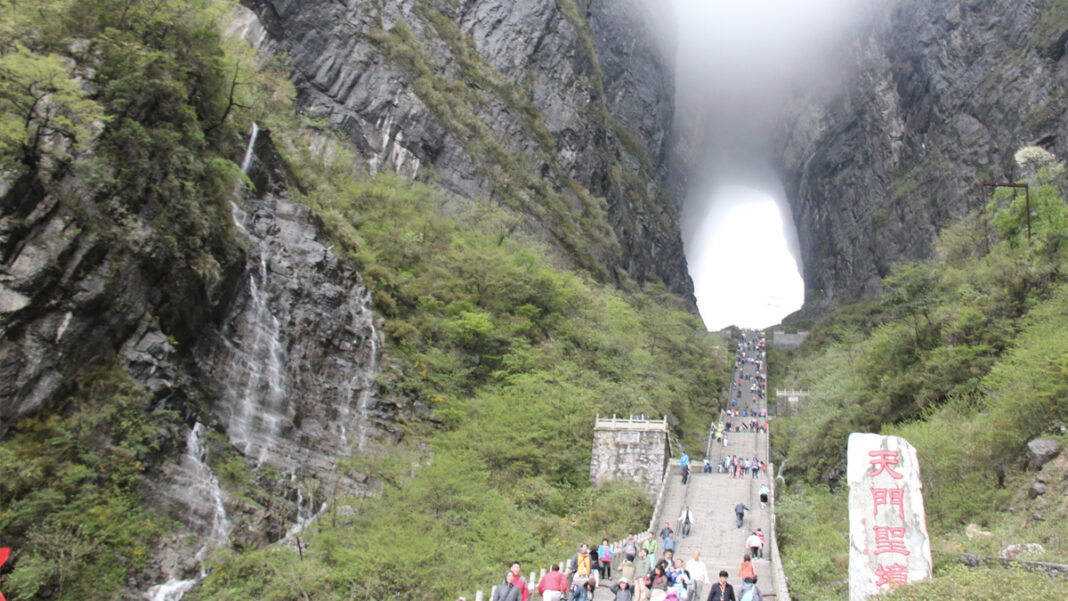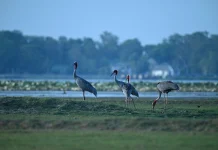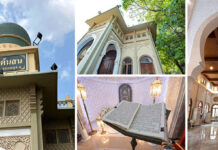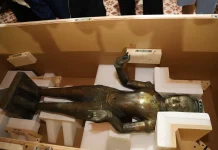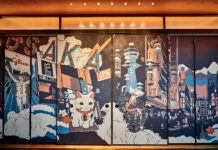Once a sleepy town in Hunan’s northwest, Zhangjiajie was unknown to most of the world until its pillar-like rock formations, the 1,080-metre Southern Sky Column, inspired the fictional world of Pandora in James Cameron’s 2009 epic “Avatar”
Today, it’s a bustling city populated mainly by tourists and while its movie star status has undoubtedly increased the incomes of the local people, the quiet that reigned for centuries has all but disappeared.
Zhangjiajie, which means “home of the Zhang family”, takes its name for Han general Zhang Liang who settled there after Liu Bang, the Han emperor, started to persecute all those who had helped him rise to power.
Our first sightseeing stop is Tianmen Mountain or more precisely Tianmen Dong, a natural hole in the mountain that has in recent years become a favourite destination for the world’s wingsuiters, who like to glide through the 30-metre wide arch.

Tourists like it too and our excitement at viewing this natural wonder quickly dissipates as we stand in the endless and noisy queue for the cable car that’s claimed to be “the world longest passenger cableway of high mountains “, with 98 cars and a total length of 7,455 metres.
“It is always like this. A long queue. That’s why we have to let Yaya, our local guide, get the tickets for us first,” says tour leader Vichien.
Even with tickets, we still have to queue. A full hour passes before we only get as far as the second floor of the building from which the cable car starts. The good news is that there are only three storeys but the bad news is there is always somebody in front of us waving to their friends at the back and these suddenly squeeze through the queue begging loudly to join their friend in the front. The queue jumpers, mostly Korean tourists, appear deaf to the very vocal complaints and frowns.
Patience is wearing thin and one member of our group finally loses her temper, shouting in Korean to the interlopers: “We all wait in the queue. Do not push in.”
Amazingly, the queue jumpers stop pushing, though they refuse to go back to their position at the end of the line.
After hours in the queue, the cable ride flashes by in the wink of an eye. Jumping out at the midway station, we are dismayed to find out that we have to queue again, this time for the shuttle bus to Tian Men Cave. The winding road makes for a fun ride but is a nightmare for anyone prone to motion sickness.

Finally, we arrive at Tianmen Cave. An almost otherworldly sight, the huge hole in the mountain makes it look like a portal to another universe.
Before the Three Kingdoms period, the mountain was known as Songliang. In 263 AD, the steep cliff face collapsed and formed a 130 metre-high and 30 metre-wide cave. Since then it’s been called Tianmen Shan, or Gate to Heaven Mountain, which perfectly describes its appearance.
“I think it looks more like a donut,” says Vichien as we slowly climb the 999 steps to the gigantic cave.
Lying to the north of Zhangjiajie City, Wulingyuan Scenic Area covers an area of 690 square kilometres and consists of four parts: Zhangjiajie National Forest Park, Suoxiyu Natural Resource Reserve, Tianzi (son of heaven) Mountain Natural Resource Reserve and Yangjiajie Scenic Area.
Suoxiyu is the centre of the scenic zone and the largest of the four areas. Shi Li Hua Lang, also known as Ten Li Gallery, is the highlight.

“Li is the traditional Chinese unit for distance. Two li equal one kilometre so you can guess from the name that the gallery is five kilometre long,” Yaya explains as we travel by rail through the scenic valley.
“Those peaks in front of us look exactly like three sisters. Oh, and one of them is pregnant too,” says Yaya.
I can make out the three sisters but trying to figure out which one is pregnant is totally beyond me.
As we make our way back to the station, a timid voice asks, “So where are the paintings? We are visiting a gallery, aren’t we?”
Laughter fills the railcar as Yaya gently explains that the whole area is a natural “art gallery”.
Getting off the train we rush to Bai Long Tianti or White Dragon Elevator, which will take us up the 356 metres to Tianzi Shan. But our hearts quickly sink as we see hordes of tourists also lining up for a ride in this vertical lift.

An hour passes then another, and we’ve not even made it to the halfway spot. Queue-jumpers are everywhere but nobody cares anymore.
The two-minute ride is totally absurd when we think of the almost three hours we’ve wasted standing in line.
The sandstone cliffs and peaks are stunning but we are hard pressed to admire Mother Nature’s glorious art. Tourists cover every inch of the walkway, especially at the Pillar of the southern sky or the “Hallelujah Mountains” as they have become known thanks to “Avatar”.
The temperature drops to eight degrees Celsius as the sun goes down and as the shivers set in, we wonder whether we too will turn as blue as the Na’vi people.
The mist thickens and the whole atmosphere morphs in a foggy world. But some things remain the same, not least the endless queue for a ride back down the mountain.

